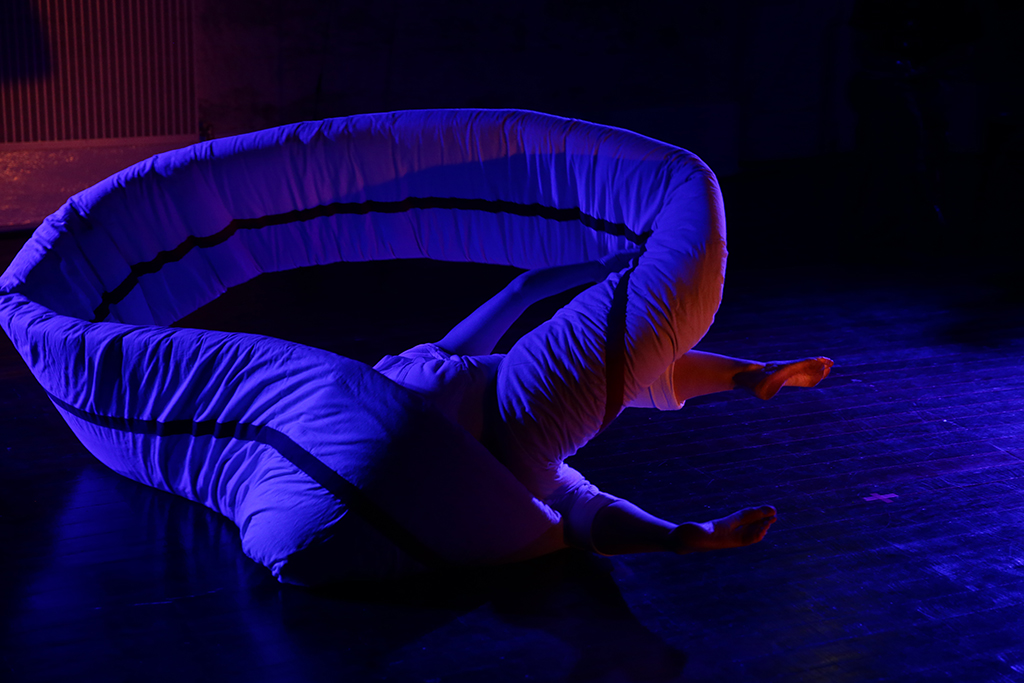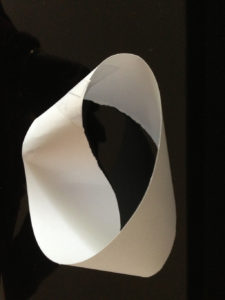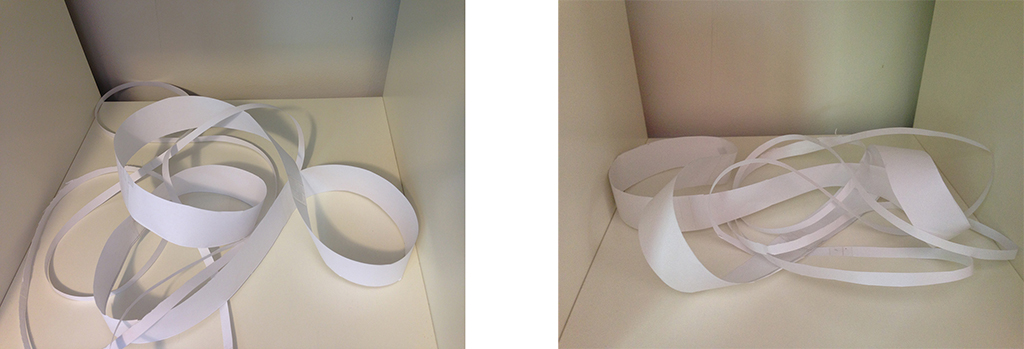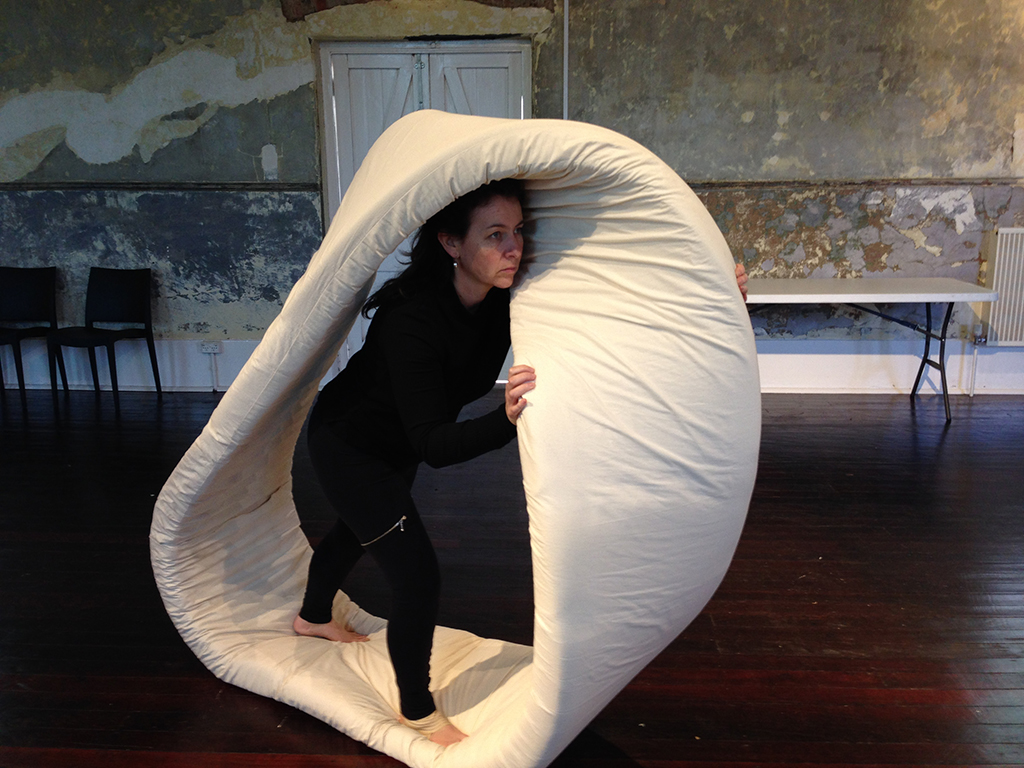
In her early work, Grosz puts forward the Möbius loop model as an alternative conceptual framework for symbolising the the “inflection of mind into body and body into mind” (1994, p. xii). I argue that, in the same way, the Möbius loop might also be an appropriate metaphor for the body-world chiasm. I have found this model particularly useful in rethinking the relations between a range of binary pairs, body/mind, subject/object, inside/outside, conscious/unconscious. As Merleau-Ponty says, “once a body-world relationship is recognized, there is ramification of my body and a ramification of the world and a correspondence between its inside and my outside, between my inside and its outside” (1964/1968, p. 136).
Grosz’s postmodern Darwinism presents all of life as modes of competing and coordinating forms of openness. These intertwining forces create conditions whereby things collide and encounter one another. I do not use the term ‘thing’ in the traditional philosophical sense, within a lineage that includes Descartes through Kant to Hegel (Grosz 2005, p. 132). I use the term ‘thing’, as Grosz does, in a Darwinian sense whereby “the thing, the object, or materiality is not conceived as the other, the binary double, of the subject, the self, embodiment, or consciousness, but is the resource for the subject’s being and enduring”(2005, p. 131).
In this intertwining body-world chiasm, things evolve, change, and adapt, and the site of action is in-between. In my view, this criss-crossing between body-world has potential to uncover, what Grosz calls, our “indeterminate creativity” (2005, p. 121) because this crisscrossing is ever-changing and always oriented toward the future.
Working kinaesthetically with the Möbius loop model helped me to develop a visceral sense of how this model might tangibly reveal the body-world chiasm. I made 3D paper models of the Möbius loop, first as a single loop (Figure 9), and then by continually dividing the original and subsequent loops one-third the distance from the edge (Figure 10). Regardless of how many divisions were made, the loop remained connected to all other loops. The kinaesthetic and spatial nature of this experience enabled me to develop a deeper appreciation of the Möbius loop’s capacity for both enacting and representing the fundamental intertwining structure of the body-world chiasm.

Figure 9: Single loop

Figure 10: Multiple loops entwined
I then created a scaled, three-dimensional test model (Figure 11), and finally a body-sized model using mattress foam, industrial thread, glue, twine, and calico (Figure 12).

Figure 11: Scaled Möbius loop model

Figure 12: Body-sized Möbius loop model
The choice of calico, a material in its raw state, referenced the conceptual ideas of my project. For example, fashion designers use calico to make test versions of a garment, called a toile. The material, therefore, references the idea of uncovering, looking beneath, and working from first principles. The addition of the central red-twine strip was to highlight the intertwining nature of things. It does this because as the red-twine strip appears and disappears it reveals the torsion of one into the other.
For me, the Möbius loop model encapsulates, as a metaphor, Merleau-Ponty’s idea that it is the intertwining “body-world” chiasm that makes us invent, create, and bring forth our subjectivities, inter-subjectivities and materialities (1964/1968, p. 136). This intertwining requires attuning to life in ways that regard bodies as “borderline or threshold” fields that hover between binary pairs in a moving spiral of action (Grosz, 1994, p. 23). I used this concept as a framework for engaging performatively with the Möbius Loop structure in a number of discovery workshops during my PhD project.
i) Encountering the Möbius Loop with Kate Barnett
In September 2015, Kate and I arranged three sessions that focused on the “spreadability of sound”. In the third session, I brought in the Möbius loop so that we could work with it in relation to sounding in preparation for my performance. We began this session by entering into a ten-minute sounding improvisation with the Möbius Loop. Our aim was to include as much as we could in our awareness and to notice what we were responding to during the improvisation. Adding in the extra dynamic of the Möbius loop proved much more difficult than I anticipated. In our post improvisation discussion, the complexities of this encounter become evident:
Angela & Kate, Recorded Dialogue September 14th 2015
A: It’s a complicated process adding in the object – sounding and working with the object feel like two really big things … what is it I’m trying to say … it took us a while to get there … I think maybe we got there towards the last minute.
K: Can you describe what “there” is?
A: Feeling connected to the multi-sensory sense of (long pause) it felt like I was forcing the work with the Möbius…the sound is a process on its own in a way and then to ….
K: So what was the work you were doing with the object?
A: There was a sensing into it, a touching of it…connecting with it ….but it felt like that was almost a separate process to the sounding.
K: That’s showing you some really interesting things about what sound is for you and what sounding is for you.
A: I felt really conflicted …yes that’s the word …because if I was giving over to the sound I was forgetting the object…even though the object was there and I was working with it…so there was a point where I was simply in the object and I wasn’t touching it …and I thought… ‘let me sound the sound of this small space that’s contained by the object’…that felt like a cleaner connection… I could allow the improvisation to evolve in a much more integrated way if I wasn’t touching the object at that time but I was aware of it so I could take in its presence.
This dialogue reveals the difficulty of holding multiple things equally in awareness. I felt pressure for it to be all that I had symbolically endowed it with. As Kate noted, “this object is a laden thing for you…it is overwhelming when you try to think of them all at once”. We continued to experiment with both of us working with the Möbius loop – what emerged was the sheer joy of the Möbius shape, the playfulness that we were able to experience in the three-way interplay and how we were tuning in and out of different aspects of the experience. For example, Kate notes:
Kate, Recorded Dialogue September 14th 2015
I loved your pulling the loop and that it changed my balance and so I went with that and sounded with that and sometimes I would more consciously think ‘oh that’s an amazing sound Angela’s making’..I want to join that in some way and then at other times I forgot you existed
Later I also note:
Angela, Recorded Dialogue September 14th 2015
It also felt good to have another body in there – I loved using the loop and moving you or being moved by it and then lifting it up – yes I felt like in those moments I was …my direction was either to the object or to the sound – even though I was doing both one had to recede for the other to happen.
As a way of addressing the conflict I was experiencing, Kate suggested that perhaps it is enough to simply be with one or the other thing, to just notice – that’s where my attention is and to just note it:
Kate, Recorded Dialogue September 14th 2015
Now I’m with the sound of this object or this movement … voice in that sense may just emerge … might be good to have the spaciousness to know that you don’t always need articulate sound to come out …note whether that would make the conflict between the foregrounding of one over another less of a conflict.
The discussion progressed further when Kate said, “your seeing is your sounding”. When I thought about this unfamiliar idea it occurred to me that I had in fact tuned into my eyes at one point. Kate probed further with “how is your vision part of your sound?”, and the following exchange emerged:
Angela & Kate, Recorded Dialogue September 14th 2015
A: Vision being part of my sound did come actually – when that (makes a sound) sound came – that was as a direct result of me attuning-to eyes and I was kind of giving a wateriness to them – squelchy
K: So was your use of sound then to enact that wateriness or was it more about being with the wateriness of the sound that emerged?
A: More about being in the wateriness of it – to feel what it sounded like to be in the gurgliness of eyes and ….oh yes it’s coming back to me now… then I let that ripple through and I got tummy and I got fat man tummy gurgling and that’s how that emerged and then at some point the loop came over the top of me and so I felt fat – I was bigger than myself and then I think you picked up on that sound
K: I did, that was one of those examples of me thinking ‘there’s a really great sound’
A: That sound came from me thinking ‘okay I need to do something here to be more multi-sensory’
K: Cool – bingo!
This exchange highlights the pedagogical nature of our sessions and how skilfully Kate allows me to make my own discoveries. The distinction Kate makes between enacting something and being something is particularly significant in this exchange. I now recognise that there is a difference between representing an idea in the body and embodying something in a cellular way. By using a sensory metaphor, I could sense into the shape and place of eyes and experience the sensation of gurgliness that was then creatively and spontaneously translated into sound. This rippled through my body in a way that took attention to tummy and fat man tummy gurgling. I note that the loop comes over me at that point and serendipitously augments this feeling of fat man tummy. This experience was somatic rather than image based. The Möbius loop enhanced and augmented what was occurring for the experiencing body in that moment. It became clear to me that I was in the experience of gurgliness and that the sound emerged from this direct experience rather than from a cognitive process where I was using sound to try and represent gurgliness.
The pathway into this experience was a process of focusing in-between things. Just prior to the gurgliness of eyes experience, I was paying attention to the points of contact between my body, the floor, the Möbius, the surrounding space, and other objects/people in space so that more and more could be included in my awareness. To achieve this, I dilate, widen, and swell my circles of attention to expand awareness and recognise the intertwining nature of things and the forces that act upon them. There is a thickness present whereby one thing affects and exponentially drives forward the other. I developed this body-attunement capacity through an exercise I adapted from a common practice that visual artists use to shift perception. Artists learn to focus attention on negative space rather than positive shapes; a foundational activity used to “perceive the shape of space” (Edwards 1979, p. 97). In a similar way, I shift my attention from the visible shape and sense of things in the world, including the experiencing body, to the invisible forces, energies and intensities that act upon and between those things. This process of applying a sensory metaphor was extremely effective in building my capacity to shift to a more immersive sense of lived experience.
The new way of experiencing eyes and the resulting sounding of eyes, where, as Kate says, my seeing is my sounding is not verifiable in any anatomical sense, but the sensory metaphor creates a visceral shift that does allow me to enter into a different kind of experience. I cannot say for sure that that my experience of gurgliness of eyes is the same as Picasso’s experience of an indigestion of green. What the two sensory metaphors share, however, is that they are body-centred and result in some form of creative output; for Picasso, a painting, and for me, sound. What I can verify is that by using a sensory metaphor, I was able to attune-to experience differently to bring forth a deeply embodied sound. Kate’s recognition that she heard a really great sound and her desire to follow it verifies too that something was different about the way this sound emerged. Our discussion became the catalyst for a deeper understanding of the visceral process that we had just shared, and thus created a moment of inter-subjective congruence.
Accessing experience in this way was initiated by focusing in-between. It involved crossing thresholds or borders, displacement, dealing with uncertainty and restriction, accepting paradox, and, importantly for this project, eschewing binary pairs. The interval between provided a fluid site for desire to connect, produce, formulate, invent, and create. Responding to this desire was about co-existence and co-creation. This desire, at first seemed intangible but that was simply because the desire is “not an object, but it is that through which objects are possible – it is between them as the interval of the trees between the trees” (Merleau-Ponty 1964/1968, p. 180). I applied this capacity to focus in-between things into my performance so that I could embody rather than represent ideas. In the next section, I discuss how Alice Cummins also helped me to embody rather than represent ideas.
ii) Encountering the Möbius Loop with Alice Cummins
In October 2015, Alice and I also did a series of discovery workshops that focused on encountering the Möbius loop. These discovery workshops helped me to clarify my relationship with it as a thing and understand how the Möbius loop could not only metaphorically represent the intertwining nature of things but, could, as a thing itself, personify something conceptual such as creativity.
In the first session, we focused on my relationship with the Möbius loop and how it might be seen as a relationship of ‘pragmatism’. Alice noted:
Alice, Recorded Dialogue, October 19th 2015
… don’t set up a confrontation with it … it’s not that it’s not about curiosity but it’s not a conceptual curiosity. It’s a cellular curiosity, and that’s also in the pragmatism – does that make sense? Otherwise all I see it through is your face, your head… I don’t see it through your body.
Alice provided the following suggestions for working with the Möbius loop on a daily basis:
Alice, Recorded Dialogue, October 19th 2015
… practise starting in different places in the space … you could start in front of it and go around it … you don’t know yet where the work will evolve. So practise coming at it from anywhere at all … just moving with it every day for set periods of time.
We discussed how I could allow the Möbius to reveal itself – without me always doing something to it. I wondered whether I needed to move slower but as Alice notes:
Alice, Recorded Dialogue, October 19th 2015
… it’s not a question of moving slowly it is a question of embodying it every single moment and that you are revealing something. What you did then was you found a place and you held it, you found a place and you held it so I don’t want that predictability … at the beginning of the session … I think there was that quality of what I would call ‘wonder’ you’re in this thing. And I think that’s the truth Angela I think sometimes we do find things magically and then the creative act is … well how do we make a pathway so that I find that every time? The rehearsal is to secure something. The research is, well what are those qualities? What are those embodied qualities? You started the session with effort and then I said this is my score for you “breathe, wrestle, sound” – three words. They are my words but perhaps you could add to them. When you do a practice that feels right to you maybe pause and write down what are the qualities that I am experiencing in my body-mind. Be careful of being wilful. It won’t respond to your wilfulness.
I learnt from this session that it was the quality of whole-bodied touch that allowed the Möbius to reveal itself. I discovered that there was less effort required. As Alice notes:
Alice, Recorded Dialogue, October 19th 2015
You don’t really know what shape it is from here, and as you said I’d only have to go touch it and it would change … it’s like an animal … it changes with one touch. (walks over to the Möbius to touch it) But the quality of touch …the quality of our attention in the creative act is what transforms things so I can do a big thing (moves Möbius) and I can also do a small thing (moves Möbius) but it changes everything – each time. It changes all the time … that is a beautiful section of the work that I would like to see you explore because for me it shows the entanglement of the body and the Möbius and that the one is the other and that is what we are doing…that inside/outside … make sense?
The following image from this discovery workshop (Figure 13), demonstrates how the object disrupts the viewer’s usual perception of the body and shows the living and the nonliving in relationship.

Figure 13: Intertwining | Photo: Alice Cummins
In these discovery workshops I learnt that the Möbius loop is a thing and, like Grosz, I follow Darwin in thinking that “the thing is the real which we both find and make” (2005, p. 132). I recognized that the thing in my project, the Möbius loop, had a history and was not “simply a passive inertia” against which I measured my own activity. As Grosz states, the thing “has a ‘life’ of its own, characteristics of its own, which we must incorporate into our activities in order to be effective, rather than simply understanding, regulating, and neutralizing it from the outside”. I discovered too that, as Grosz notes, “we need to “accommodate things more than they accommodate us” (2005, p. 132).
In the next session with Alice, we focused on the concept of creativity. Alice raised questions about creativity and how this idea related to the Möbius loop. She asked, “What shape is creativity? What are you calling up? Who are you calling up? What is it that you are wanting to invoke? (Alice, recorded dialogue 26 October, 2015). These questions helped me to articulate my intentions and I responded:
Angela, recorded dialogue October 26th 2015
In some way the Möbius loop is the shape of creativity and maybe I’m invoking that in my body before I even get to it. I mean it is the manifestation of my idea of creativity – the seen and the unseen.
Alice and I discussed the many facets of creativity and my intention to reveal an aspect of these different facets within each vignette of my performance. As an experiment we decided to actively endow the Möbius loop with the idea that it was creativity itself in a five-minute improvisation. Afterwards Alice noted:
Alice, Recorded Dialogue October 26th 2015
What I saw was that you tried to plead your way back into the relationship with creativity and what you’re revealing here is something of great interest to me – creativity is not passive – it’s a dynamic force so sometimes you have to jump on board … almost like it’s out of control. You had an accident and were cast off, so you had to get on board again and grab it. But the creativity manifests in all sorts of ways and one of its manifestations is playfulness, violence, physicality… it’s not refined and polite.
Alice also mentioned the “numinousness” of creativity; that creativity is “of other, not human”. She noted “creativity is in your service … you are not dominating it … it is a constantly shifting relationship…maybe it even fools you into thinking you’re in charge briefly” (Alice, Recorded Dialogue October 26th 2015). This exchange was important in helping me to further embrace the non-human forces present in evolutionary and immersive conditions of life. Alice and I also discussed how difficult it is to maintain the fresh, spontaneous quality of the work that is present the first time you do something. Alice noted:
Alice, Recorded Dialogue, October 26th 2015
That is the amazing thing about the practice – what you have to do is keep the practice going – the spontaneity of the early stuff has to still be there after a hundred practises and I think it can be, as you find more in it … don’t lock things in too early…you absolutely need to keep opening it out ….
Alice encouraged me to keep going with the work but to “do it through the practice, not by sitting with a piece of paper, feel it in your body”. These sessions integrated the BMC and improvisation work with Alice and the body-centred practice with Kate that I had done over the three years of my PhD project. In the next section, I describe how this work with the Möbius loop model was translated into performance.
